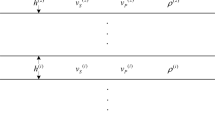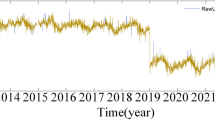Abstract
This paper investigates the performance of normalized response function obtained by normalizing the Cagniard impedance function by a suitable factor and then rotating the phase by 45‡ to make it purely real for homogeneous half-space and equal to the square root of the half-space resistivity. Two apparent resistivity functions based on respectively the real and imaginary parts of this response function are proposed. The apparent resistivity function using the real part contains almost the same information as that yielded by the Cagniard expression while the one using the imaginary part qualitatively works as an indicator of the number of interfaces in the earth model. The linear straightforward inversion scheme (SIS), developed by the authors employing the concept of equal penetration layers, has been used to validate the proposed apparent resistivity functions. For this purpose, several synthetic and field models have been examined. Five synthetic models are studied to establish the veracity of the new functions and two well-studied published field data sets are inverted through SIS for comparison. We noticed that the new function and SIS compliment each other and lead to better understanding of the data information and model resolution.
Similar content being viewed by others
References
Backus G E and Gilbert J E 1970 Uniqueness in the inversion of inaccurate gross earth data;Phil. Trans. Roy. Soc. London 266 123–192.
Bailey R C 1970 Inversion of the geomagnetic induction problem;Proc. Roy. Soc. London 315 185–194.
Basokur A T 1994 Definitions of apparent resistivity for the presentation of magnetotelluric sounding data;Geophysical Prospecting 42 141–149.
Berdichevsky M N and Zhdanov M S 1984 Advanced theory of deep geomagnetic Sounding; (Elsevier, Amsterdam).
Cagniard L 1953 Basic theory of magnetotelluric method of geophysical prospecting;Geophysics 18 605–635.
Constable C C, Parker R L and Constable C G 1987 Occam’s inversion: A practical algorithm for generating smooth models from electromagnetic sounding data;Geophysics 52 289–300.
Cull J P 1985 Magnetotelluric soundings over a Precambrian contact in Australia;Geophys. J. Roy. Astr. Soc. 80 661–675.
Fisher F, Schnegg P A, Pegurion M and Le Quang B V 1981 An analytic one dimensional magnetotelluric inversion scheme;Geophys. J. Roy. Astr. Soc. 67 257–278.
Gupta P K, Sri Niwas and Gaur V K 1996 Straightforward inversion scheme (SIS) for one-dimensional magnetotelluric data;Proc. Indian Acad. Sci. (Earth Planet. Sci.) 105 413–429.
Gupta P K, Sri Niwas and Gaur V K 1997 Straightforward inversion of vertical electrical sounding data;Geophysics 62 775–785.
Jones A G and Hutton R 1979 A multi-station magnetotelluric study in southern Scotland I. Fieldwork, data analysis and results;Geophys. J. Astr. Soc. 56 329–349.
Kunetz G 1972 Processing and interpretation of magnetotelluric soundings;Geophysics 37 1005–1021.
Loewenthal D 1975 Theoretical uniqueness of the magnetotelluric inverse problem for equal penetration discretizable models;Geophys. J. Roy. Astr. Soc. 43 897–903.
Oldenburg D W 1990 Inversion of electromagnetic data: An overview of new techniques;Geophys. Surv. 11 231–270.
Parker R L 1980 The inverse problem of electromagnetic induction: Existence and construction of solutions based upon incomplete data;J. Geophys. Res. 85 4421–4428.
Parker R L and Whaler K A 1981 Numerical methods for establishing solutions to the inverse problem of electromagnetic induction;J. Geophys. Res. 86 9574–9584.
Pederesen J F and Hermance 1986 Least-square inversion of one-dimensional magnetotelluric data: An assessment of procedures employed by Brown University;Surv. Geophys. 8 187–231.
Spies B R and Eggers D E 1986 The use and misuse of apparent resistivity in electromagnetic method;Geophysics 51 1462–1471.
Weidelt P 1972 The inverse problem of geomagnetic induction;Z. fur. Geophys. 38 257–289.
Whittal K P and Oldenburg D W 1986 Inversion of magnetotelluric data using a practical inverse scattering formulation;Geophysics 51 383–395.
Author information
Authors and Affiliations
Rights and permissions
About this article
Cite this article
Niwas, S., Gupta, P.K. & Gaur, V.K. Normalized impedance function and the straightforward inversion scheme for magnetotelluric data. J Earth Syst Sci 114, 523–531 (2005). https://doi.org/10.1007/BF02702028
Received:
Revised:
Accepted:
Issue Date:
DOI: https://doi.org/10.1007/BF02702028




